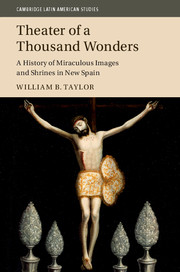Book contents
- Frontmatter
- Dedication
- Contents
- List of Figures
- List of Maps
- List of Tables
- Preface and Acknowledgments
- Archive Abbreviations
- Introduction
- Part I Bearings: Historical Patterns and Places of Image Shrines
- Part II Soundings: Divine Presence, Place, and the Power of Things
- Conclusion
- Appendix 1 Colonial Image Shrines
- Appendix 2 When Shrines Began
- Appendix 3 Other Saints
- Index
Appendix 2 - When Shrines Began
Published online by Cambridge University Press: 05 September 2016
- Frontmatter
- Dedication
- Contents
- List of Figures
- List of Maps
- List of Tables
- Preface and Acknowledgments
- Archive Abbreviations
- Introduction
- Part I Bearings: Historical Patterns and Places of Image Shrines
- Part II Soundings: Divine Presence, Place, and the Power of Things
- Conclusion
- Appendix 1 Colonial Image Shrines
- Appendix 2 When Shrines Began
- Appendix 3 Other Saints
- Index
Summary
When did a miraculous image become established and gain fame and a following beyond the immediate vicinity? When was it regarded as a shrine? The answer is uncertain for most of the many celebrated images and shrines in colonial Mexico. Even colonial era chroniclers of shrines lamented a lack of evidence about their early years beyond reputation – la voz pública y fama, as they called it.
Sources used to compile the lists in Appendix 1 are used again here, although more selectively. Published provincial chronicles and compendia by Florencia and Oviedo, Vetancurt, Torquemada, Lizana, Tello, Burgoa, Veytia, Mota Padilla, Escobar, Cabrera y Quintero, and other colonial authors were helpful starting points, but more certain dates come from early devotional histories of particular shrines, novena booklets published mainly in the eighteenth century, a group of formal investigations into miracle traditions conducted during the seventeenth and eighteenth centuries, pastoral visit books, colonial gazettes and diaries of public events (efemérides), and scattered administrative and judicial records across three centuries. The lack of serial records for most shrines and the selective, hagiographical nature of nearly all the narrative sources make dating a difficult, often frustrating endeavor. The challenges of tracking particular shrines over time are evident in the chapters of this book. Here, briefly, are two examples of how establishing when a shrine began is confounded by fragmentary and fugitive evidence.
The image of Nuestra Señora de los Rayos of Temastián, Jalisco, may well have been made and then acquired by the community of Temastián before the end of the sixteenth century, and the image was later housed in a chapel built during the early seventeenth century, but popular devotion is more clearly documented later, in the late eighteenth century. As a shrine, should it be included in the sixteenth, seventeenth, or eighteenth-century list of beginnings?
The testimony of local residents, when it is recorded in colonial records, usually is not much help in dating unless the devotion had begun recently. For example, in 1776, when the ecclesiastical judge for Tlalpujahua (in Michoacán near the Estado de México border) queried residents about the antiquity of the miraculous image of Nuestra Señora del Carmen and devotion to her in a chapel on the edge of town, no one could say more specifically than that it had been there “from time immemorial,” when a miner built a chapel.
- Type
- Chapter
- Information
- Theater of a Thousand WondersA History of Miraculous Images and Shrines in New Spain, pp. 592 - 603Publisher: Cambridge University PressPrint publication year: 2016



